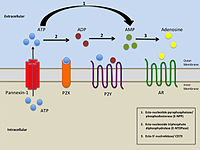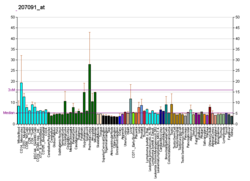| Part of a series on |
| Purinergic signalling |
|---|
 |
| Concepts |
| Membrane transporters |
P2X purinoceptor 7 is a protein that in humans is encoded by the P2RX7 gene.[5][6]
The product of this gene belongs to the family of purinoceptors for ATP. Multiple alternatively spliced variants which would encode different isoforms have been identified although some fit nonsense-mediated decay criteria.[7]
The receptor is found in the central and peripheral nervous systems, in microglia, in macrophages, in uterine endometrium, and in the retina.[8][9][10][11][12][13][14] The P2X7 receptor also serves as a pattern recognition receptor for extracellular ATP-mediated apoptotic cell death,[15][16][17] regulation of receptor trafficking,[18] mast cell degranulation,[19][20] and inflammation.[21][19][20][22] Regarding inflammation, P2X7 receptor induces the NLRP3 inflammasome in myeloid cells and leads to interleukin-1beta release.[23]
- ^ a b c GRCh38: Ensembl release 89: ENSG00000089041 – Ensembl, May 2017
- ^ a b c GRCm38: Ensembl release 89: ENSMUSG00000029468 – Ensembl, May 2017
- ^ "Human PubMed Reference:". National Center for Biotechnology Information, U.S. National Library of Medicine.
- ^ "Mouse PubMed Reference:". National Center for Biotechnology Information, U.S. National Library of Medicine.
- ^ Rassendren F, Buell GN, Virginio C, Collo G, North RA, Surprenant A (February 1997). "The permeabilizing ATP receptor, P2X7. Cloning and expression of a human cDNA". The Journal of Biological Chemistry. 272 (9): 5482–6. doi:10.1074/jbc.272.9.5482. PMID 9038151.
- ^ Buell GN, Talabot F, Gos A, Lorenz J, Lai E, Morris MA, Antonarakis SE (Feb 1999). "Gene structure and chromosomal localization of the human P2X7 receptor". Receptors & Channels. 5 (6): 347–54. PMID 9826911.
- ^ "Entrez Gene: P2RX7 purinergic receptor P2X, ligand-gated ion channel, 7".
- ^ Faria RX, Freitas HR, Reis RA (June 2017). "P2X7 receptor large pore signaling in avian Müller glial cells". Journal of Bioenergetics and Biomembranes. 49 (3): 215–229. doi:10.1007/s10863-017-9717-9. PMID 28573491. S2CID 4122579.
- ^ Cite error: The named reference
:1was invoked but never defined (see the help page). - ^ Cite error: The named reference
:2was invoked but never defined (see the help page). - ^ Deuchars SA, Atkinson L, Brooke RE, Musa H, Milligan CJ, Batten TF, et al. (September 2001). "Neuronal P2X7 receptors are targeted to presynaptic terminals in the central and peripheral nervous systems". The Journal of Neuroscience. 21 (18): 7143–52. doi:10.1523/JNEUROSCI.21-18-07143.2001. PMC 6762981. PMID 11549725.
- ^ Collo G, Neidhart S, Kawashima E, Kosco-Vilbois M, North RA, Buell G (September 1997). "Tissue distribution of the P2X7 receptor". Neuropharmacology. 36 (9): 1277–83. doi:10.1016/S0028-3908(97)00140-8. PMID 9364482. S2CID 21491471.
- ^ Slater NM, Barden JA, Murphy CR (June 2000). "Distributional changes of purinergic receptor subtypes (P2X 1-7) in uterine epithelial cells during early pregnancy". The Histochemical Journal. 32 (6): 365–72. doi:10.1023/A:1004017714702. PMID 10943851. S2CID 40282870.
- ^ Ishii K, Kaneda M, Li H, Rockland KS, Hashikawa T (May 2003). "Neuron-specific distribution of P2X7 purinergic receptors in the monkey retina". The Journal of Comparative Neurology. 459 (3): 267–77. doi:10.1002/cne.10608. PMID 12655509. S2CID 9692745.
- ^ Freitas (2019). "Interaction between cannabinoid and nucleotide systems as a new mechanism of signaling in retinal cell death". Neural Regeneration Research. 14 (12): 2093–2094. doi:10.4103/1673-5374.262585. PMC 6788250. PMID 31397346.
- ^ Freitas HR, Isaac AR, Silva TM, Diniz GO, Dos Santos Dabdab Y, Bockmann EC, et al. (September 2019). "Cannabinoids Induce Cell Death and Promote P2X7 Receptor Signaling in Retinal Glial Progenitors in Culture". Molecular Neurobiology. 56 (9): 6472–6486. doi:10.1007/s12035-019-1537-y. PMID 30838518. S2CID 71143662.
- ^ Kawano A, Tsukimoto M, Noguchi T, Hotta N, Harada H, Takenouchi T, et al. (March 2012). "Involvement of P2X4 receptor in P2X7 receptor-dependent cell death of mouse macrophages". Biochemical and Biophysical Research Communications. 419 (2): 374–80. doi:10.1016/j.bbrc.2012.01.156. PMID 22349510.
- ^ Qu Y, Dubyak GR (June 2009). "P2X7 receptors regulate multiple types of membrane trafficking responses and non-classical secretion pathways". Purinergic Signalling. 5 (2): 163–73. doi:10.1007/s11302-009-9132-8. PMC 2686822. PMID 19189228.
- ^ a b Kurashima Y, Kiyono H (March 2014). "New era for mucosal mast cells: their roles in inflammation, allergic immune responses and adjuvant development". Experimental & Molecular Medicine. 46 (3): e83. doi:10.1038/emm.2014.7. PMC 3972796. PMID 24626169.
- ^ a b Wareham KJ, Seward EP (June 2016). "P2X7 receptors induce degranulation in human mast cells". Purinergic Signalling. 12 (2): 235–46. doi:10.1007/s11302-016-9497-4. PMC 4854833. PMID 26910735.
- ^ Gonzaga DT, Ferreira LB, Moreira Maramaldo Costa TE, von Ranke NL, Anastácio Furtado Pacheco P, Sposito Simões AP, et al. (October 2017). "1-Aryl-1H- and 2-aryl-2H-1,2,3-triazole derivatives blockade P2X7 receptor in vitro and inflammatory response in vivo". European Journal of Medicinal Chemistry. 139: 698–717. doi:10.1016/j.ejmech.2017.08.034. PMID 28858765.
- ^ Russo MV, McGavern DB (October 2015). "Immune Surveillance of the CNS following Infection and Injury". Trends in Immunology. 36 (10): 637–650. doi:10.1016/j.it.2015.08.002. PMC 4592776. PMID 26431941.
- ^ Pelegrin, Pablo; Barroso-Gutierrez, Consuelo; Surprenant, Annmarie (2008-06-01). "P2X7 receptor differentially couples to distinct release pathways for IL-1beta in mouse macrophage". Journal of Immunology. 180 (11): 7147–7157. doi:10.4049/jimmunol.180.11.7147. ISSN 0022-1767. PMID 18490713.




